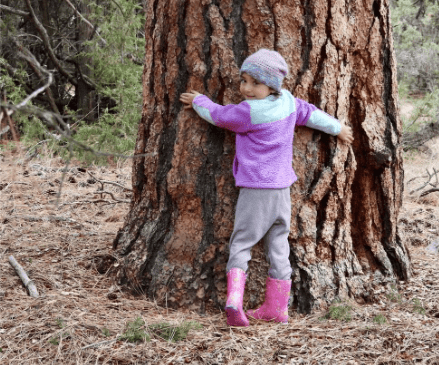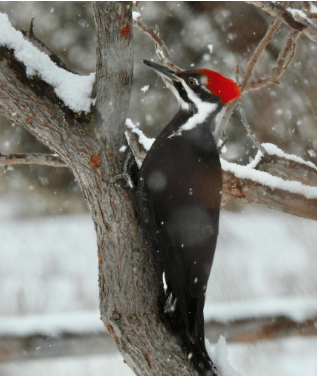by Micki Long, Bitterroot Forest Collaborative
We stare up, through hundreds of branches, large and small, trying to see the top of a huge, old-growth Ponderosa Pine. We think about all that has happened in the human world since this pine was a seedling. Numerous owl pellets at the base of the tree tell us that an owl, mostly likely a Great Horned Owl, roosts here often. Many feel awe in the presence of large, mature, and old-growth trees. Throughout human history, many cultures and religions have revered trees. For example, the Bible mentions trees over 525 times. Scientific discoveries about trees and their importance in ecosystems have led to an explosion of books aimed at a general audience.

A little one who hopes this huge, old Ponderosa Pine will still be standing long after she herself is old. Photo courtesy Micki Long.
Management of old-growth stands is often a contentious issue in projects proposed by the Bitterroot National Forest (BNF). The mission of the Bitterroot Forest Collaborative (BFC), one of over 25 groups participating in the Montana Collaborative Forest Network, is “to influence the design and expedite the implementation of forest management proposals on public lands in a manner which reflects the desires of Bitterroot Valley residents, minimizes adverse environmental impacts, and supports ecosystem function.” Our collaborative defines “old-growth forests as ecosystems distinguished by old trees and related structural attributes such as snags, down woody material, and multiple canopy layers.” Persuaded by research, we see old-growth forests as crucial backbones of forest landscapes.

Pileated Woodpecker. Photo by Micki Long.
One way old-growth and mature trees contribute to a healthy forest ecosystem is by providing habitat for certain species. As our Position Statement on Special Habitats says, “Certain species on the Bitterroot Forest are associated with mature forest habitats or old growth. These animals require habitat with structural components such as snags, down logs, and large, old trees for cover, denning, food, or nesting. Examples include fisher, flammulated owls, pileated woodpeckers, and pine marten, the latter two being old growth management indicator species.” Continued loss of old-growth habitat makes survival more challenging for these species, threatening the rich diversity of wildlife on the BNF.
BFC is not alone in assigning a high value to old-growth trees and stands. Public comments on BNF projects, like Gold Butterfly on the east side of the valley, show high support for preserving old growth. These comments align with the more general support for preservation of habitat among Western voters. Colorado College’s recently released 15th Annual State of Rockies Project Conservation in the West poll showed that “60 percent [of responding Western voters] oppose expanding the amount of national forest and other public lands available to private companies for logging.” As public input on individual forest projects faces an uncertain future, other sources, like this poll, will provide land managers with important information about public perspectives.
The following are just some of the recommendations in our Position Paper on Special Habitats. To see the full paper and papers on other forest management issues, see https://montanaforestcollaboration.org/app/home/committees/bitterroot/
To the extent possible, retain all or nearly all old/large trees. Retain and expand on existing relict trees, old forests, and post-disturbance large snags and down logs in these types.
Forest managers should protect existing old-growth habitat and manage vegetation to accelerate the replacement of ecologically functioning old growth where there is a deficit of existing old growth or where old -growth habitat is likely to be lost to normal forest succession and/or wildfire in the immediate future.
Any prescriptive vegetation management in old growth should not decrease old growth percentages in any 3rd order drainages in a given project area.

Steve Schmidt says
Thank you Micki. This is an important issue.
Jim Parker says
President Trump’s recent Executive Orders place the sanctity of Old Growth on the sacrifice altar of the Timber Industry. And that’s not all, the prospect of “Fast Tracking” for the Sheep Creek Mine authorized by his EO’s threatens to poison the water nourishing all living things in the Bitterroot Valley. Write your representatives in Congress. Urge them to keep the Sheep Creek Mine OFF the priority execution list.
Mike Miller says
How is this an “opinion” as well as a “news” story? Is this more of Victoria’s “I make the rules around here!”?